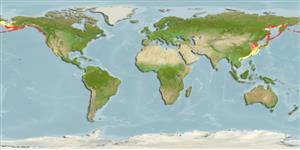分類 / Names
共通名の | 類義語 | Catalog of Fishes(部類, 種) | ITIS | CoL | WoRMS | Cloffa
>
Perciformes/Cottoidei (Sculpins) >
Agonidae (Poachers) > Brachyopsinae
Etymology: Pallasina: Because of Petrus Simon Pallas, ichthyologist and explorer of Siberia and Asia. He studied the geology, botany and zoology, working in the laboratory of Ichthyology created by Peter the Great. He observed the transit of Venus. Berlin, 1741-1811.
More on author: Steindachner.
Environment: milieu / climate zone / depth range / distribution range
生態学
海 底生の; 深さの範囲 0 - 105 m (Ref. 50550). Temperate
North Pacific: Sea of Japan to the Bering Sea and to Bodega Bay, central California, USA. Past works (e.g. Hart 1973, Ref. 6885) recognized two subspecies, Pallasina barbata barbata occurring in the Bering Sea and along the Asian coast through the Sea of Okhotsk to Japan and Pallasina barbata aix occurring from the Gulf of Alaska to California, USA, as well as Kamchatka and Japan. Sheiko 1993 on the other hand recognizes both Pallasina barbata and Pallasina aix as valid species (Ref. 26282).
サイズ / 重さ / 年齢
Maturity: Lm ? range ? - ? cm
Max length : 17.0 cm TL オス/雌雄の選別がない; (Ref. 56557)
背面の脊椎 (合計): 5 - 8; 背鰭 (合計): 6-9; 肛門の骨 0; 臀鰭: 8 - 13. Caudal fin rounded (Ref. 28197). Preserved specimens dark brown, darker dorsally, paler ventrally (Ref. 28197). A stripe on head, from tip of snout to, through part between temporal ridge and uppermost preopercular spine, to posterior upper part of opercle (Ref. 28197). Fins pale, except for the dark caudal fin (Ref. 28197). Tiny spots on dorsal and pectoral fin rays (Ref. 28197).
Inhabits intertidal areas and to 55 m depth, possibly to 128 m (Ref. 2850). Often found among eelgrasses or seaweeds (Ref. 2850).
Life cycle and mating behavior
成熟 | 繁殖 | 放精 | 卵 | 生産力 | 幼生
Kanayama, T., 1991. Taxonomy and phylogeny of the family Agonidae (Pisces: Scorpaenifomes). Mem. Fac. Fish. Hokkaido Univ. (38)1-2:1-199. (Ref. 28197)
Human uses
より多くの情報
共通名の類義語代謝捕食動物生態毒性繁殖成熟放精卵の集合体生産力卵卵の開発
参考文献水産養殖水産養殖の紹介緊張遺伝子のElectrophoreses遺伝病気行列NutrientsMass conversion
協力者画像Stamps, Coins Misc.音シガテラ(食中毒の名前)速度泳ぐ 型式カマOtoliths脳視覚
用具
特記事項
XMLをダウンロードして下さい
インターネットの情報源
Estimates based on models
Preferred temperature (Ref.
123201): 1.4 - 14.8, mean 4.2 °C (based on 913 cells).
Phylogenetic diversity index (Ref.
82804): PD
50 = 1.0000 [Uniqueness, from 0.5 = low to 2.0 = high].
Bayesian length-weight: a=0.00389 (0.00180 - 0.00842), b=3.12 (2.94 - 3.30), in cm total length, based on all LWR estimates for this body shape (Ref.
93245).
栄養段階 (Ref.
69278): 3.2 ±0.3 se; based on diet studies.
回復力 (Ref.
120179): 手段, 1.4年~4.4年の倍増期間の最小個体群 (Preliminary K or Fecundity.).
Fishing Vulnerability (Ref.
59153): Low vulnerability (10 of 100).
